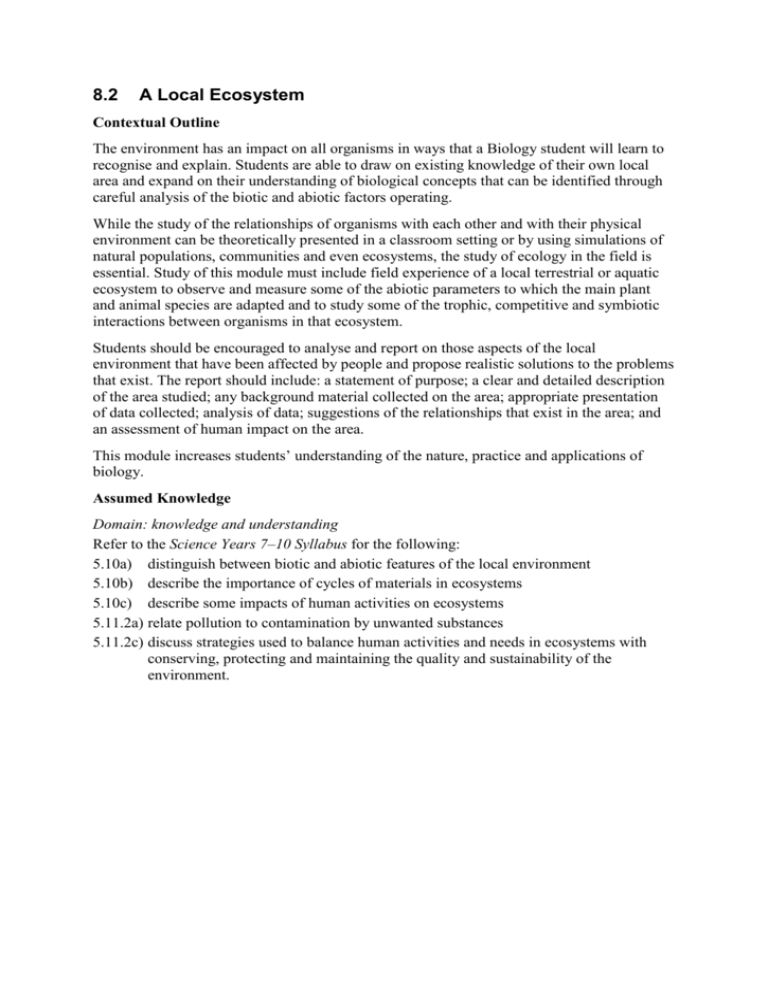A local Ecosystem sysllabus
advertisement

8.2 A Local Ecosystem Contextual Outline The environment has an impact on all organisms in ways that a Biology student will learn to recognise and explain. Students are able to draw on existing knowledge of their own local area and expand on their understanding of biological concepts that can be identified through careful analysis of the biotic and abiotic factors operating. While the study of the relationships of organisms with each other and with their physical environment can be theoretically presented in a classroom setting or by using simulations of natural populations, communities and even ecosystems, the study of ecology in the field is essential. Study of this module must include field experience of a local terrestrial or aquatic ecosystem to observe and measure some of the abiotic parameters to which the main plant and animal species are adapted and to study some of the trophic, competitive and symbiotic interactions between organisms in that ecosystem. Students should be encouraged to analyse and report on those aspects of the local environment that have been affected by people and propose realistic solutions to the problems that exist. The report should include: a statement of purpose; a clear and detailed description of the area studied; any background material collected on the area; appropriate presentation of data collected; analysis of data; suggestions of the relationships that exist in the area; and an assessment of human impact on the area. This module increases students’ understanding of the nature, practice and applications of biology. Assumed Knowledge Domain: knowledge and understanding Refer to the Science Years 7–10 Syllabus for the following: 5.10a) distinguish between biotic and abiotic features of the local environment 5.10b) describe the importance of cycles of materials in ecosystems 5.10c) describe some impacts of human activities on ecosystems 5.11.2a) relate pollution to contamination by unwanted substances 5.11.2c) discuss strategies used to balance human activities and needs in ecosystems with conserving, protecting and maintaining the quality and sustainability of the environment. 1. The distribution, diversity and numbers of plants and animals found in ecosystems are determined by biotic and abiotic factors Students learn to: Students: compare the abiotic characteristics of aquatic and terrestrial environments identify the factors determining the distribution and abundance of a species in each environment describe the roles of photosynthesis and respiration in ecosystems identify uses of energy by organisms identify the general equation for aerobic cellular respiration and outline this as a summary of a chain of biochemical reactions process and analyse information obtained from a variety of sampling studies to justify the use of different sampling techniques to make population estimates when total counts cannot be performed Students learn to: 2. Each local aquatic or terrestrial ecosystem is unique Students: examine trends in population estimates choose equipment or resources and undertake a field study of a local for some plant and animal species terrestrial or aquatic ecosystem to within an ecosystem identify data sources and: – measure abiotic variables in the outline factors that affect numbers in ecosystem being studied using predator and prey populations in the appropriate instruments and relate area studied this data to the distribution of organisms identify examples of allelopathy, – estimate the size of a plant parasitism, mutualism and population and an animal commensalism in an ecosystem and population in the ecosystem using the role of organisms in each type of transects and/or random quadrats relationship – collect, analyse and present data to describe the distribution of the plant describe the role of decomposers in and animal species whose ecosystems abundance has been estimated – describe two trophic interactions explain trophic interactions between found between organisms in the organisms in an ecosystem using food area studied chains, food webs and pyramids of – identify data sources and gather, biomass and energy present and analyse data by: - tabulation of data collected in define the term adaptation and discuss the study the problems associated with inferring calculation of mean values with characteristics of organisms as ranges adaptations for living in a particular graphing changes with time in habitat the measured abiotic data evaluating variability in identify some adaptations of living measurements made during things to factors in their environment scientific investigations identify and describe in detail gather information from first-hand and adaptations of a plant and an animal secondary sources to construct food from the local ecosystem chains and food webs to illustrate the relationships between member species describe and explain the short-term in an ecosystem and long-term consequences on the process and analyse information and ecosystem of species competing for present a report of the investigation of resources an ecosystem in which the purpose is introduced, the methods described and identify the impact of humans in the the results shown graphically and use ecosystem studied available evidence to discuss their relevance









